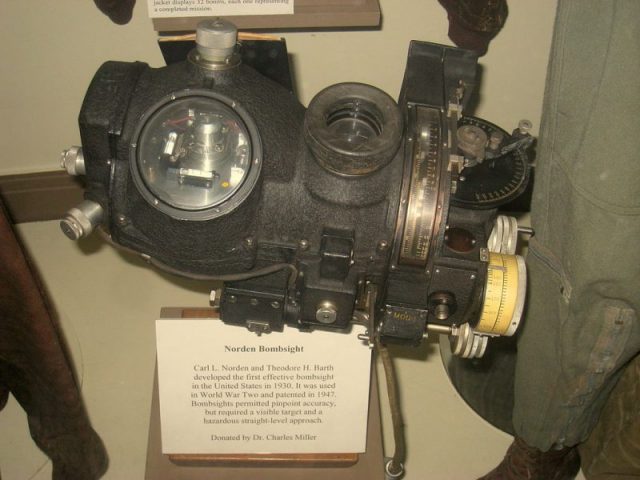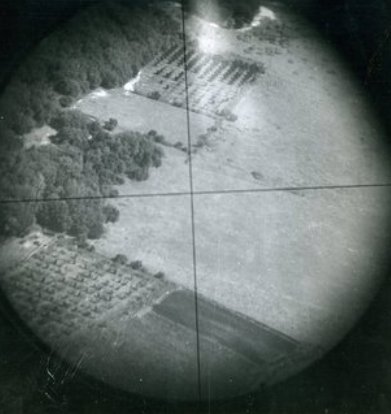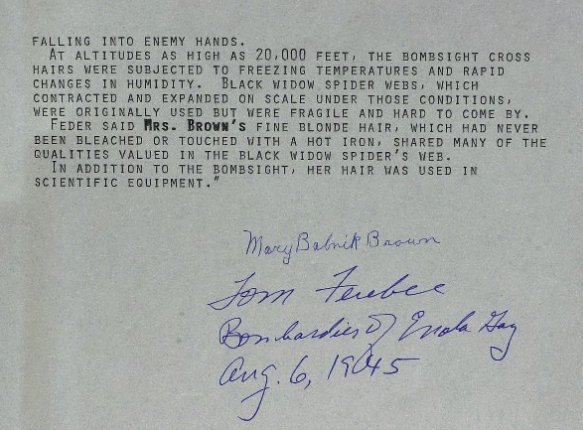Even though the technology of war is constantly being improved, research and development isn’t always as quick as the military needs. That was certainly true during World War II.
In an era when things like lasers or computer-assisted anything were still dreams, dropping bombs from aircraft was somewhat hit-or-miss, and bombardiers could only rely on their own training and experience.
One legendary piece of equipment that, according to the National Museum of the U.S. Air Force, “was crucial to the success of the U.S. Army Air Forces’ daylight bombing campaign during World War II” was the Norden bombsight.

The Museum of Aviation writes that it was developed by Dutch engineer Carl L. Norden throughout the 1920s, and the Mark 15 Norden bombsight was acquired by the U.S. Army Air Corps in 1931.
This sophisticated device was a game changer, enabling (in peacetime testing) what was at the time a remarkable accuracy of 75 feet for daylight bombing from high altitude.

It is a widely upheld WWII urban myth that, while Norden got less credit than he deserved for his invention’s impact on the war effort, another person who was absolutely critical to the manufacture of the Norden bombsight is even less remembered. Her name was Mary Babnik Brown.
The bombsight required crosshairs to help pinpoint its targets, and the material used had to be strong enough to handle the radical temperature changes, stresses, and sheer abuse that the airplanes were regularly subjected to.
The story goes that finding a workable material proved to be challenging. One of the first things Norden’s company supposedly tried using was black-widow spider silk, but this didn’t prove sturdy enough to withstand the rigors it would undergo.

Eventually, Norden’s company figured out that the best, most durable solution to the problem was human hair. It needed to be long, blond, and never exposed to any processing or chemicals — or even heat, such as from curling irons — that could compromise its strength.
Mary Babnik Brown from Pueblo, Colorado was a dancer who was locally renowned for her was 34-inches-long blond hair, reaching nearly to her knees. Brown took great care of her hair and she only ever washed it with simple shampoos, meaning that it met all the necessary criteria.

She answered an ad from a newspaper asking for women who might be willing to donate their hair to the war effort. The ad claimed it would be used for meteorological applications. Brown sent a sample of her hair, which was thoroughly examined for suitability, and it was deemed ideal.
The government asked if she would cut off her hair and she agreed, feeling it was her patriotic duty to support the war effort in any way she could. She even refused the war saving stamps she was offered as recompense for her sacrifice. She felt that sacrifice keenly, too, as she reportedly cried for a good two months after her hair was cut.

According to Revolvy, after being collected as part of a clandestine operation for use in the bombsights, her hair was also used in scientific equipment to make precise measurements of humidity during the manufacture of military planes and other equipment.
Brown had no idea what her hair had actually been used for. However, on her 80th birthday, in 1987, she received a letter from President Ronald Reagan. He thanked Brown for her contribution to the war effort, casually mentioning that her hair had been used in the Norden bombsights.

While various websites confidently recount the tale of Mary Babnik Brown’s hair, others claim that Mary’s story is simply an urban legend which has subsequently been debunked.
According to the Museum of Aviation Foundation, the human hair crosshairs tale is “Probably the most popular myth that still prevails to this day.” Writing about the Norden bombsight, the museum states that, as a way to encourage a belief that bombs could be dropped with pin-point accuracy, and thus with minimal accidental innocent casualties, “The Army Air Forces set in motion a propaganda campaign which eventually took a life of its own.” The reality was that in combat, bombing accuracy depended largely on the skill and experience of the bombardier.
However, on November 17, 1990, the Colorado Aviation Historical Society gave Brown a special achievement award, and Paul Harvey even told her tale on his show, The Rest of the Story, on November 19, 1990. The city of Pueblo, Colorado named November 22, 1991 to be “Mary Babnik Brown Day.”
Whether Mary’s story is a true one or not, it’s still a tale that caught the public imagination. The patriotic Rapunzel is a model of commitment to supporting the war effort, even at some real personal cost.
Read another story from us: The ‘British Schindler’ who Saved 669 Children from the Horrors of WWII
Her story reminds us that, in order for a nation to be truly strong, its citizens need to take an active role in helping to keep it that way. It’s also a reminder that being a citizen of a nation, any nation, means more than just inhabiting it.
